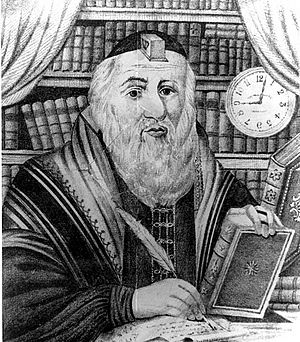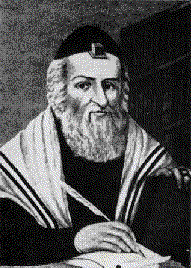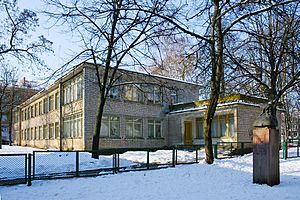Vilna Gaon facts for kids
Quick facts for kids Elijah ben Solomon Zalman |
|
|---|---|
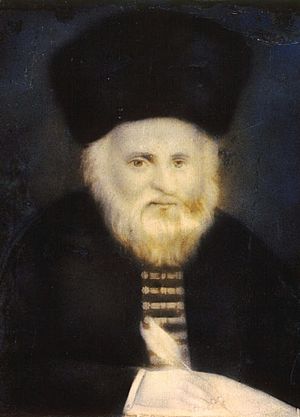
Vilna Gaon
|
|
| Religion | Judaism |
| Denomination | Orthodox Judaism |
| Personal | |
| Nationality | Polish-Lithuanian |
| Born | Elijah ben Solomon Zalman April 23, 1720 Sialiec, Polish–Lithuanian Commonwealth |
| Died | October 9, 1797 (aged 77) Vilnius, Vilna Governorate, Russian Empire |
| Senior posting | |
| Title | Vilna Gaon Elijah of Vilna Gra |
| Yahrtzeit | 19 Tishrei |
| Buried | Vilnius, Lithuania |
Elijah ben Solomon Zalman, known as the Vilna Gaon (which means "the genius from Vilnius"), was a very important Jewish leader. He was born in Sialiec, in the Polish-Lithuanian Commonwealth, on April 23, 1720. He passed away in Vilnius on October 9, 1797, at 77 years old.
He was a brilliant scholar of the Talmud (a central text of Jewish law) and Kabbalah (Jewish mysticism). He was also the main leader of the Misnagdim, a group that opposed the Hasidic movement. People often called him "the pious genius from Vilnius."
Through his many notes and corrections on religious texts, he became one of the most influential figures in Jewish study. Many Jewish schools, called yeshivas, still follow his specific customs and rites, known as "minhag ha-Gra." This is also a common custom for Ashkenazi Jews in Jerusalem.
Even as a child, the Gaon showed amazing talent. By age twenty, other rabbis asked him for help with their hardest legal questions. He wrote many books, though none were published while he was alive. He also encouraged his students to learn about science.
Contents
The Vilna Gaon: A Great Jewish Scholar
Early Life and Amazing Talent
Elijah Ben Solomon Zalman was born in Sialiec, a town in what was then the Polish-Lithuanian Commonwealth. This was on April 23, 1720. He came from a family of well-known rabbis.
Legend says he had memorized the entire Tanakh (the Hebrew Bible) by the age of four. When he was seven, he began studying the Talmud. His teacher was Moses Margalit, who later became a famous rabbi.
The Gaon had an incredible memory. By the time he was eight, he was also studying astronomy in his free time. From age ten, he continued his studies without a teacher. By age eleven, he had memorized the entire Talmud.
Later, he traveled to different parts of Europe, including Poland and Germany. By the age of twenty, rabbis from all over asked him for his legal opinions. He returned to his hometown in 1748, already very famous.
How He Studied
The Gaon used a special way to study the Talmud and other religious books. He carefully checked the texts to make sure they were accurate. He spent a lot of time studying the Torah and Hebrew grammar. He also knew a lot about the sciences of his time.
He told his students to study in a simple and direct way. He believed they should not ignore other subjects like science. He thought that learning about science could actually help them understand Judaism better. The Gaon was also interested in Kabbalah, which is a mystical part of Judaism.
The Vilna Gaon was a very humble person. He often refused offers to become a rabbi. In his later years, he even stopped giving official approvals for books. He lived a quiet life, teaching only a few chosen students from time to time.
Standing Up to Hasidism
When Hasidic Judaism started to become popular in Vilnius, the Vilna Gaon disagreed with it. He joined other rabbis and community leaders in Poland to speak out against the Hasidic movement.
In 1781, the Hasidim began trying to attract more followers. The Gaon again spoke out against them. He said they were teaching wrong ideas and that religious Jews should not marry into Hasidic families.
His Other Important Work
Besides his disagreements with the Hasidim, the Vilna Gaon rarely got involved in public matters. He did not lead a large school in Vilnius. Instead, he taught a small group of students in his study hall. He taught them Hebrew grammar, the Hebrew Bible, and the Mishnah. These subjects were often overlooked by other scholars at the time.
He especially wanted his students to study midrash literature and the lesser-known parts of the Talmud. He also stressed the importance of studying the Jerusalem Talmud, which had been mostly ignored for centuries.
The Gaon encouraged his main student, Rabbi Chaim Volozhin, to start a yeshiva (a Jewish academy). This yeshiva would teach Jewish literature in a new way. Rabbi Chaim Volozhin opened the Volozhin yeshiva in 1803, a few years after the Gaon passed away. This school changed how Torah was studied and had a big impact on all of Orthodox Judaism.
A Simple Life
The Vilna Gaon lived a very simple and strict life. Some people at the time called him "the Hasid." This word means "pious person" and does not refer to the Hasidic movement.
The Gaon once started a trip to the Land of Israel. However, he did not get past Germany for reasons we don't know. While in Königsberg (now Kaliningrad), he wrote a famous letter to his family. This letter was later published as Alim li-Terufah.
His Writings
The Vilna Gaon wrote many notes and short commentaries. He usually dictated these to his students. Many believe that his students were the ones who wrote down his comments. None of his writings were published during his lifetime.
The Gaon was very careful with how his commentaries were written. He believed that only the "written law" (the Tanakh) should be written down. The "oral law" (Torah sheb'al peh) should not be, unless absolutely necessary. Because of this, his explanations are often very short and hard for anyone but advanced scholars to understand.
His notes on the Babylonian Talmud and Shulchan Aruch are called Bi'urei ha-Gra. His commentary on the Mishnah is titled Shenoth Eliyahu. He also wrote commentaries on various Kabbalistic works. His thoughts on the Pentateuch are called Adereth Eliyahu. Later in his life, he wrote commentaries on the Proverbs and other books of the Tanakh.
He knew a lot about the mathematical works of Euclid. He encouraged his student, Rabbi Baruch Schick of Shklov, to translate these works into Hebrew. The Gaon is also said to have written a short math book called Ayil Meshulash. This book was an introduction to basic mathematics.
Lasting Impact
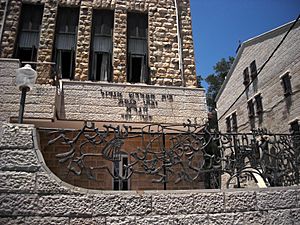
The Vilna Gaon was one of the most important Jewish leaders since the Middle Ages. Even though he lived later, many people consider him to be as important as the earlier great rabbis.
His main student, Rabbi Chaim Volozhin, started the first yeshiva in his hometown of Volozhin, Belarus. This school changed how Torah was studied. Before this, young people and scholars usually studied freely in synagogues. They might travel to towns with famous rabbis. The Volozhin Yeshiva created a formal way of studying. It had qualified teachers, provided meals, and offered places to stay. This way of studying is now common in Orthodox Judaism.
Interestingly, some leaders of the Haskalah (Jewish Enlightenment) movement used the Vilna Gaon's study methods. They liked his focus on understanding the simple meaning of texts. They also liked his interest in Hebrew grammar and checking religious texts carefully.
Following the Vilna Gaon's wishes, three groups of his students and their families moved to the Land of Israel between 1808 and 1812. There were over 500 people in these groups. This was one of the first modern Jewish migrations to Palestine. These students, called Perushim, settled first in Safed and later in Jerusalem.
Their arrival in Jerusalem was very important. For over 100 years, Jerusalem had mostly Sephardi Jews. The Perushim helped bring back the presence of Ashkenazi Jews in Jerusalem. Their customs, based on the Vilna Gaon's teachings, became very influential there.
Even today, the Vilna Gaon's impact can be seen in the religious practices of Israeli Jews. For example, the custom of priests giving blessings every weekday, and the accepted time for Shabbat to begin in Jerusalem, both come from his traditions. The Perushim also started several study centers and founded the Jerusalem neighborhood of Mea Shearim. They also helped rebuild the Hurva Synagogue, which had been in ruins for 140 years.
There is a statue of the Vilna Gaon and a street named after him in Vilnius, Lithuania. In 2020, Lithuania's parliament declared it the year of the Vilna Gaon. The Bank of Lithuania even made a special 10-euro coin with Hebrew letters to honor him.
His brother, Avraham, wrote an important book called "Maalot Hatorah." His son, Abraham ben Elijah of Vilna, was also a respected scholar.
His Final Years
The Vilna Gaon passed away in 1797 when he was 77 years old. He was buried in the Šnipiškės cemetery in Vilnius. This cemetery was later closed in 1831.
Where He is Buried
In the 1950s, the Soviet government planned to build a stadium on the cemetery site. They allowed the Vilna Gaon's remains to be moved. He was re-buried in a new cemetery.
See also
 In Spanish: Gaón de Vilna para niños
In Spanish: Gaón de Vilna para niños
- Hasidim and Misnagdim
- Lithuanian Jews
- Misnagdim
- Perushim
- Vilna Gaon Jewish State Museum


